 |
 |
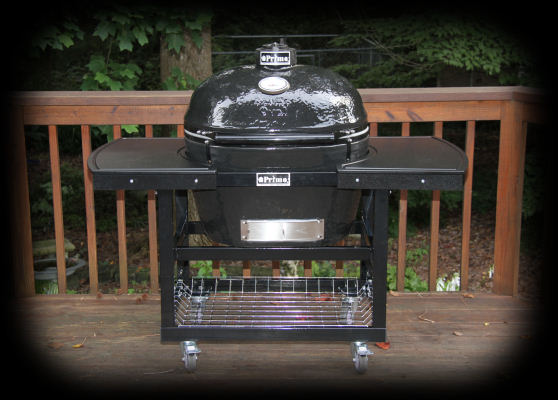
Accessories
In the way of accessories, Primo sent us quite an array of items:
|
|
|

Let's take a look at some of these accessories:
The Cart
You have a bit of a selection from Primo as to what you do in the way of a cart or table. There are different styles of tables available in cypress and teak woods. The cart we were sent is the standard cart base and the two piece island top. Starting from the top down in the photo below on the left, we see the two fixed side tables. Below them is the framework upon which the cooker rests. Below that is wire basket. The photo below on the right shows the "notch" in the back of the frame that accomodates the hinge mechanism when you open the lid.
The cart itself it made from powder coated steel. The basket is made from galvanized steel. The island top is "constructed of the highest marine grade materials and UV Inhibitors for the ultimate in weather resistance. FDA approved food safe and stain, mold and mildew resistant."
Here are some key dimenions:
The photo on the left shows one of the two island top pieces while the center photo below shows a closeup of the work top surface. Finally, the photo on the right shows a close up view of one of the wheels on the cart. The two front wheels are locking, while the two back wheels are not. One word about these wheels, they roll VERY smoothly and easily. When rolling your cart about, you have to be careful not to get up too much speed as you will be surprised at how easily the cart rolls.
A word about the side tables and heat. No, we didn't melt one. We did ask the manufacturer about the suitability of the tables for holding hot items. They replied that you should treat it like a Corian® countertop. Here is what DuPont has to say about Corian® and heat:
"We do not recommend placing a hot pot directly on Corian® surfaces. Although Corian® solid surface remains stable and undamaged in temperatures up to 212ºF (100ºC), high heat or flame will damage your surface. To protect your Corian® surfaces from heat damage, always use a hot pad or a trivet with rubber feet when using hot pots, or heat-generating appliances, like electric skillets or electric cooking pots."So Primo doesn't recommend putting hot pots or hot grates on the tables. Plates of hot food are ok, but not a hot Dutch oven without protection. Also, do not use it for a cutting board unless you don't mind getting cut marks on the surfaces.

9-Slot Rib Rack
The 9-Slot Rib Rack is designed to hold 9 slabs or racks of ribs. As we'll see in a bit, the 5-Slot Rib Rack is designed to sit right on top of the large rack to give you the ability to hold 14 racks of ribs, where we are calling a "rack" something like St. Louis style ribs that are trimmed back to just the bones. The rib rack is made of porcelain covered steel, just like the grates. Here are some dimensions:

5-Slot Rib Rack
The 5-Slot Rib Rack is very similar to the 9-Slot Rib Rack, just shorter. The frame of the small rack is 11 inches long and has openings for 5 racks/slabs of ribs. We mentioned that you can set the small rack on top of the large rack to hold 14 racks of ribs in all. The two are designed so that the small rack will sit on top of the large rack without slipping off sideways. We know the photos below aren't so hot, but it's hard to take a photo of nothing but a bunch of black rods cris-crossing all over the place. However, if you trim your ribs sufficiently, you can do 14 trimmed racks of ribs at once.
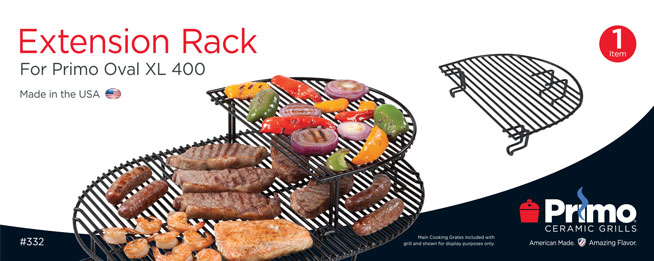
Extension Rack
Now we come to the extension racks which provide you with a second raised level of cooking 4½ inches above the main grates. These come one to a box, so you can choose to buy either one or two as your needs dictate. If you buy two and place them both on the regular racks, you have a second layer shaped like a discorectangle (remember?) that is 22¼ inches wide by 15½ inches deep. This creates a cooking space approximately 293 square inches in size. Needless to say, if you only use one extension rack, you get an extra 146½ square inches of cooking space.
The rods on the extension racks are 3/16 inches in diameter and are spaced 1/2 inch apart on center. (The main grates, you may remember, were 7/32 inches in diamter and spaced 9/16 inches apart on center.)
As you can see from the photo below on the right, you can also choose to place a main grate on the fire box upside down and then place an extension rack on the inverted main grate. If you do this, the inverted main grate and the extension rack will be approximately 2 inches lower than their counterparts in the conventional position.
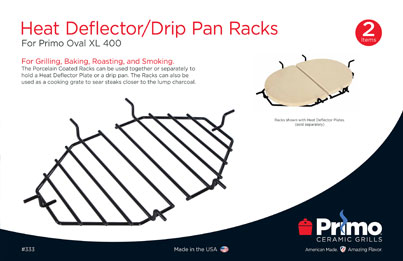
The Heat Deflector/Drip Pan Racks provide a level upon which to rest drip pans. This level is approximately 1½ inches below the top of the firebox, and 3½ inches below the regular grate. Below you can see what various size drip pans look like resting on the Heat Deflector/Drip Pan Racks:

Ceramic Heat Deflector Plates
The Ceramic Heat Deflector Plates are two substantial ceramic plates that rest on the heat deflector/drip pan racks for indirect cooking. You can use one or both in order to create indirect cooking on either half the cooker or the whole cooker. The plates each measure 10½ inches front to back, 13¾ inches wide and 5/16 inches thick. When in place there is about a 2½ inch gap between the top of the ceramic reflector and the regular grid above it.
You can wrap the heat deflector plates in foil to keep them clean from food residue and drippings. We did this for all the cooking we did and it makes cleanup much easier and the plates are much more pleasant to handle.
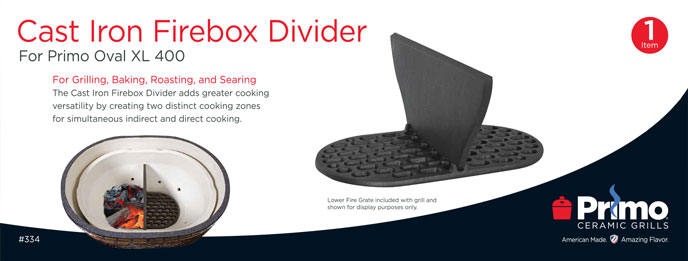
Cast Iron Firebox Divider
Now we have the Cast Iron Firebox Divider. It is a very heavy piece of metal which fits into the notches on the fire grate so that you can divide the firebox into two sections. The main use of this is to allow you to build a fire on one side of the firebox giving you a hot zone over the fire exposed to the radiant heat of the fire, and a cooler zone on the other side of the cooker not directly exposed to the fire. As you will see in a later section, we did much of our test cooking using a setup with a ceramic plate underneath the "cool" zone so as to roast/smoke food away from the radiant heat of the fire. The divider is just under 6 inches tall and spans the firebox front to back, so you can stack quite a bit of charcoal on one side or the other.
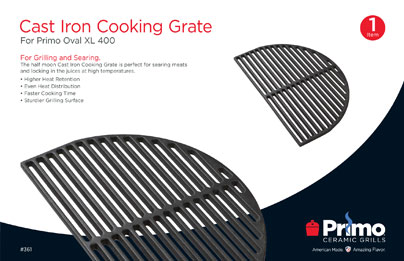
Cast Iron Cooking Grate
Next on the list is the Cast Iron Cooking Grate. It is roughly the same shape and size as the normal grids, but obviously is made from cast iron. It is thick and heavy (10 pounds, 2 ounces) and should do a great job with grilling. It rests on the firebox as you can see in the photos below. The grate is spaced approximately ¾ inches on center. As you can see, each rod is trapezoidal in shape, meaning the bottom of each rod is wider than the top. The bottom is ½ inch wide while the top is ¼ inch wide. The overall grate is ⅜ inch thick.
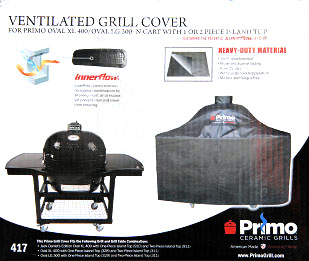
Ventilated Grill Cover
Primo sells a heavy ventilated grill cover for this cooker. It has some nice features such as straps on the end to draw the cover snug so that it doesn't fly off in the wind. There is a custom pocket in the top to go over the top vent. There is also a ventilation vent in the back to allow moisture inside to get out, but it keeps the rain out.
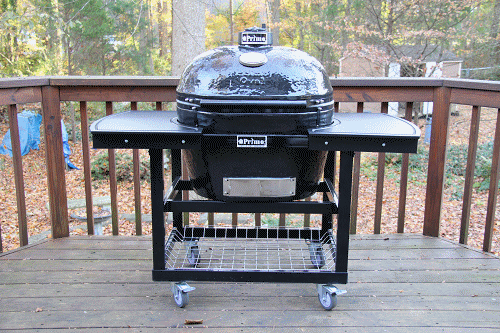
Baking Stone
Primo also has a baking stone available. The one we were sent is glazed on one side and bare ceramic on the other side. It is 15½ inches in diameter and 9/16" thick. However, you can get them either in the natural ceramic finish or like ours, glazed on one side. Also, they come in 13 and 16-inch sizes.
Ash Tool
And now to the lowly ash tool. We hope it is obvious that it is used to scrape ash out of the cooker. It is about 19⅜ inches long:
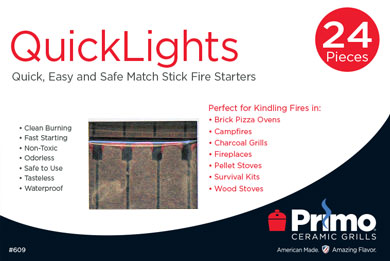
Primo QuickLights
Lastly, we played around with the Primo QuickLights we were sent. They come two plastic-wrapped packages to a box, each package containing 12 QuickLights for a total of 24 lights. Just for fun, we decided to compare these QuickLights with some Rutland starter squares, since many people are familiar with the Rutland product or one of the branded versions.
Each Primo Quicklight is ½ x ¾ x 2-5/16 inches in size. A Rutland square is 1⅝ x 1⅞ x 7/16 inches, or about 1.33 times larger in volume than the Primo Quicklight.
The Primo QuickLights are essentially like matches. You strike them on the scratching surface on the edge of the box, and the red coating on the tip ignites which then lights the Quicklight. The Rutland squares have to be lit with a match or other source of flame.
The Rutland squares are quite eager to catch fire, but the Primo QuickLights' flame is rather fragile at the start. You need to keep it out of any wind and encourage the flame by holding the Quicklight in a position to help the flame spread.
The Primo Quicklight has no odor before lighting and only a very slight odor when burning. The Rutland squares have a slight odor before lighting and a fairly strong wax/parafin odor while burning.
The Primo Quicklight burns for about 11½ minutes with a relatively modest flame. The Rutland square burns for about 10⅓ minutes with a more robust flame.
You can support this website by shopping at The Naked Whiz Website Store and Amazon.com
|